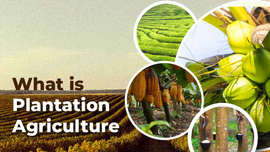
Almond is a common dry fruit in Indian kitchens. But have you ever wondered where these nutrient-rich nuts come from and how they're grown right here in India?
In this article, we'll learn more about Almond cultivation in India and the process of growing Almonds, their varieties and best farming practices for Almond cultivation.
Table of Content
- Introduction
- Where do Almonds Grow in India?
- Different Varieties of Almond Grown in India
- Important Steps to Almond Cultivation
Introduction
The Almond tree (Prunus dulcis) is native to the Mediterranean region and is considered one of the oldest tree nuts in the world. In India, it was first introduced to Kashmir during the 16th century by Persian settlers. Today, Jammu & Kashmir, Himachal Pradesh, and Maharashtra are the leaders in growing almond plants for producing high-yielding nuts.
Almonds are healthy and nutritious nuts, considered a well-balanced, cholesterol-free food. They are low in saturated fat and contain many other protective nutrients. They contain Calcium and magnesium, which are good for strong bones, as well as vitamin E and compounds called phytochemicals, which help protect against cardiovascular disease and even cancer. Almonds are also used for various purposes, such as in sweets, milk, and as a nut in food, as well as in the production of oils.
Where Do Almonds Grow in India?
India's almond-growing belt is mainly nestled in the cooler regions of the country. States like Jammu & Kashmir, Himachal Pradesh, and parts of Uttarakhand provide the perfect environment for almond cultivation. Jammu & Kashmir produced about 9.93 thousand MT of almonds in 2020-21. Himachal Pradesh was the second-highest producer with 1.35 thousand MT of almond production.
Different Varieties of Almond Grown in India

There are many varieties of almonds available in India. Some of the popular varieties include:
|
Almond Variety |
Regions grown |
Features |
|
Mukhdoom |
Jammu & Kashmir, Himachal Pradesh. |
|
|
Waris |
Jammu & Kashmir |
|
|
Shalimar |
Kashmir |
|
|
Pranyaj |
Jammu & Kashmir, Himachal Pradesh, Maharashtra |
|
|
Merced |
Jammu & Kashmir |
|
|
Non Pareil |
Jammu & Kashmir, Himachal Pradesh |
|
Important Steps to Almond Cultivation
Soil & Climate Requirement
Almonds grow in deep, well-drained loamy soils. Sandy loam and clay loam soil are also suitable, as long as they do not hold excess water. Waterlogged soil is often the leading cause of root rot. Soil should be at least 1.5 to 2 meters deep, which allows for proper root development. For Almond cultivation, a pH level between 6.0 to 7.5 is usually preferred.
Almonds require a Mediterranean climate with slightly hot summers (30-35 °C) and mild winters for optimal plant growth and kernel filling. Unopened blooms can withstand temperatures as low as -2.2 °C.
Propagation of Almond Plants
Grafting in almond trees is usually done in either winter or summer, depending on the technique used. In July, when the sap flow is ideal, scion wood from the desired almond variety is budded or grafted onto seedling rootstocks that are about the thickness of a pencil. The best method for this is ‘T’ or Shield budding, done about 10 cm above the ground. The grafting is done in the month of March following wedge method.
Planting
The grafted or budded plants should be planted in a square system with a spacing of 3.5 X 3.5 X 2.5 m (high-density planting system), 4 X 4 m (medium high-density system), or 6 X 6 m (standard planting system). During the months of September and October, each pit of 3 X 3 X 3 ft size should be dug. The plants should be placed in the centre of the pit between February and March, with suitable bamboo supports to shield the trees from wind and other elements. Mulch around the plant to help retain moisture and prevent weeds.
Irrigation & Water Management
For young plantings, use sufficient water to settle the soil around the roots, then water every 10-15 days to maintain the appropriate moisture level. The annual water requirement for almond trees is approximately 300-400 mm. Flowering (February to March) and fruit development (April, May, and June) are the two most vulnerable periods of almond growth due to water shortages. Irrigation must be provided at these stages. Mulching tree basins with straw or black polythene helps to store moisture and reduce irrigation intervals.
Drip irrigation is another highly effective method, suitable for irrigating the almond field. This will not just help with timely irrigation but will also help with efficient water management.
Nutrient Management
Almonds are heavy feeders; therefore, they require a large amount of manure and fertiliser. It is advised that well-rotted farm yard manure (FYM) be applied to each tree at a rate of 20-25 kg/tree during the winter fall (December-January). Urea can be applied in 2-3 divided doses. The first half dose should be applied along with DAP (full) and MOP (full) a fortnight before projected bloom, the second dose (1/4th) of Urea should be applied about 3 weeks after fruit set, and the third dose (1/4th) of Urea should be applied in May-June. A urea foliar spray at 1.5-2 per cent concentration can additionally be used to promote fruiting bud formation and subsequent growth the following season.
Pest & Disease Control
Almond trees, like all crops, can be affected by pests and diseases. For this reason, preventing any soil-borne diseases and pest control is crucial for the long-term health of almond orchards. Here are common almond pest and diseases along with effective control methods:
|
Pest / Disease |
Symptoms |
Control Strategies |
|
Ants |
Infest fallen nuts; cause nut damage. |
Use baits (e.g., abamectin Methoprene) 4 – 10 weeks before harvest. |
|
Navel Orangeworm (NOW) |
Larvae bore into nuts, direct kernel damage. |
Timely use of insecticides. |
|
Peach Twig Borer |
Larvae tunnel in shoots and nuts. |
Prune out infested shoots, and targeted larvicides. |
|
Spider Mites |
Early leave drooping, retarded growth and weakened fruit buds. |
Dormant oil emulsion spray or delayed dormant spray with diesel oil. |
|
Shot Hole (Leaf Spot) |
The leaves, twigs and fruits develop small, round to irregular. |
The tree may be sprayed with 0.2% Captan 50 WP or 0.3 Copper Mancozeb 75% WP. |
|
Leaf Curl |
The leaf blade becomes thickened and puckered along the midrib; leaf curls and turns yellowish. |
Spray the tree before bud burst with 0.25 Captan 50 WP or 0.3 Copper Oxchloride. |
Harvesting & Post-Harvest Management
In late July, the shell begins to break and changes colour from green to yellow. In August, splits can widen and expose more of the nut's shell, allowing it to dry. The nuts are typically gathered by hand plucking. Rain can degrade nut quality throughout the harvest period, causing nuts to turn black to dark brown in colour. Harvesting is done manually or by knocking the branches with sticks; Later, the outer shell is removed manually.
Nuts are sun dried or dried using hot air until their moisture content reaches 5-7%. Poly tunnels with fans can also be used for best and hygienic drying. Nuts are then dehulled and shelled.
Frequently Asked Questions On Guide to Almond Farming in India
1. How many different types of almonds are there?
There are many different types of almonds, but a few prominent ones include California almonds, Mamra almonds, Gurbandi almonds.
2. Which almond is costly in India?
Mamra Badams are the most expensive variety of almonds.
3. Which state is the largest producer of almonds in India?
Jammu & Kashmir is the highest almond producing state in the country.


Related Blogs












